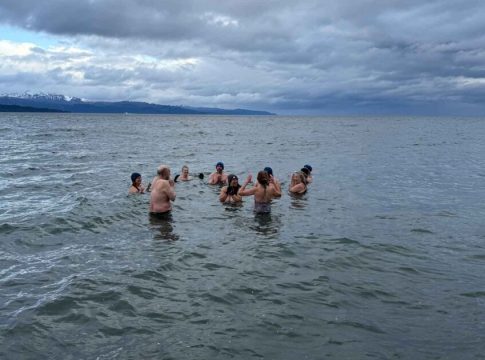The Benefits of Cold Plunging: A Journey into Mental Well-Being
As the waves of Kachemak Bay crash against the sandy shores of Homer Spit in Alaska, a unique ritual unfolds. Led by Kammi Matson, a devoted advocate for mental wellness, a group of individuals gathers to immerse themselves in the invigorating embrace of the cold ocean water. This practice, known as cold plunging, offers not just a physical challenge but also a path to emotional resilience and community connection.
Embracing the Chill
Cold plunging involves submerging oneself in cold water, which can evoke profound and immediate reactions in the body. Participants often report a mix of anxiety and excitement as they prepare to confront the icy waves. Matson, who has been organizing these plunges for three years, emphasizes that the initial moments can feel overwhelming; however, once acclimatized, plungers often find themselves in a shared space of tranquility and gratitude.
“The first few minutes are the toughest,” Matson explains. “But as you settle into the cold, a sense of peace often washes over you.” Many participants, including Matson herself, have observed positive transformations in their mental health as a result of this practice. It can serve as a form of release, helping alleviate feelings of anxiety and stress.
The Science Behind Cold Water Immersion
While anecdotal evidence suggests that cold water immersion can enhance mood and reduce stress, the scientific community is still exploring its full range of benefits. Some studies indicate that exposure to cold water may help in managing stress hormones, yet research remains limited.
Safety First: Monitoring Your Limits
Dr. Blaine Norton, an emergency department physician, highlights the importance of safety in these ventures. Cold water poses risks such as hypothermia and unexpected emotional responses. He advises participants to:
- Stay within water temperatures of 40 to 60 degrees Fahrenheit for safety.
- Consult a healthcare professional if they have pre-existing heart or circulation issues.
- Avoid plunging alone; having a buddy system can be vital for safety in case of emergencies.
Additionally, it’s imperative to listen to one’s body and recognize when it’s time to exit the water. As one participant mentioned, “Note to self: Listen to my body.” Elevating this awareness can lead to a more empowering and safer experience.
Building Community and Resilience
One of the often-overlooked benefits of cold plunging is the sense of community it fosters. As individuals wade into cold waters together, they cultivate bonds rooted in shared vulnerability and strength. Jennifer Gibson, a therapist and cold plunge enthusiast, articulates this beautifully: “It teaches you that you are strong and capable of overcoming challenges.”
Through this practice, participants learn to embrace discomfort and grow from it, enhancing their mental fortitude.
Conclusion: A Cold Plunge Towards Inner Peace
Emerging from the cold water, Matson often feels a rush of exhilaration and peace. “I feel invincible,” she reflects, embodying the empowerment that comes from facing fears and pushing boundaries. Ultimately, cold plunging serves as more than just a physical activity; it’s an opportunity for emotional healing and profound connection to oneself and others.
For those curious about cold plunging, consider starting slowly and with a supportive community. This practice may not only provide a refreshing jolt to your system but also pave the way for deeper insights into your own resilience and emotional well-being.

Covers wellness, nutrition, mental health, and daily life tips.
Bio: Talia brings a background in health journalism and holistic living to help readers live better, one tip at a time.

